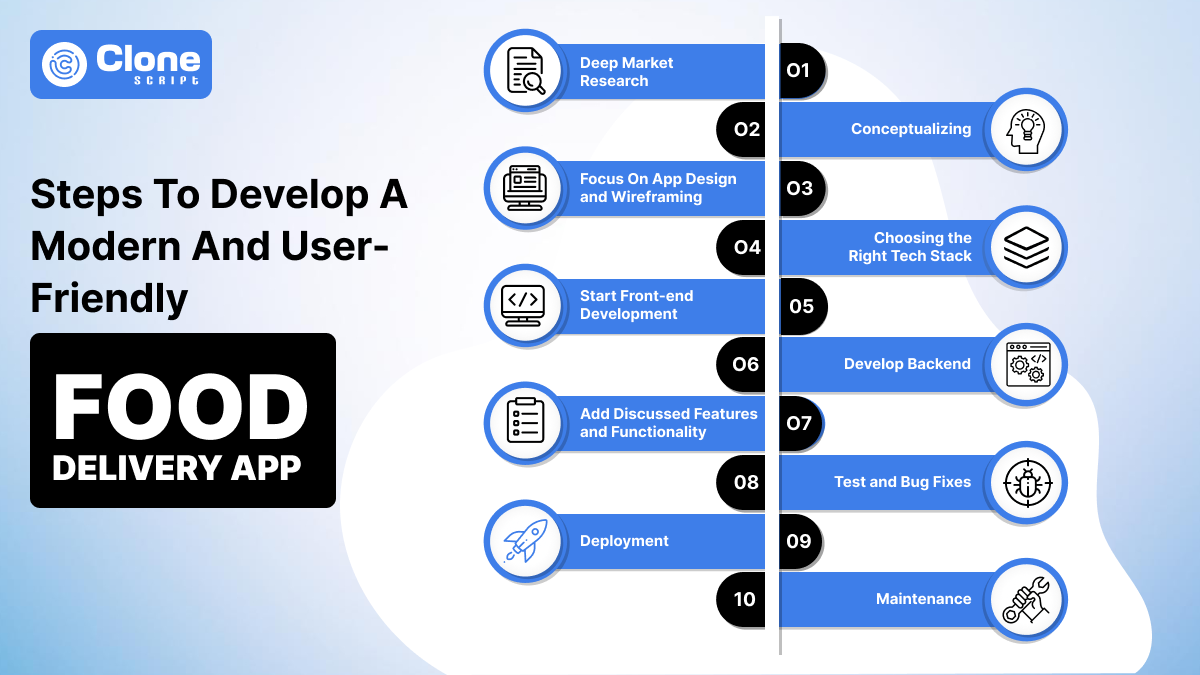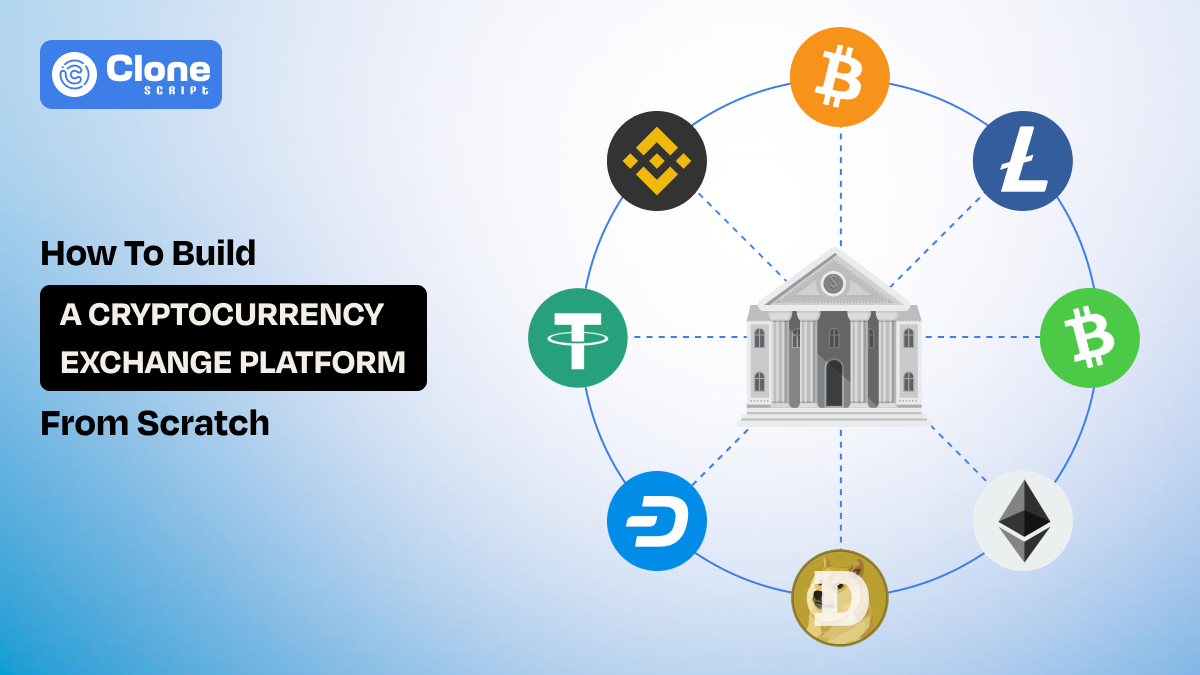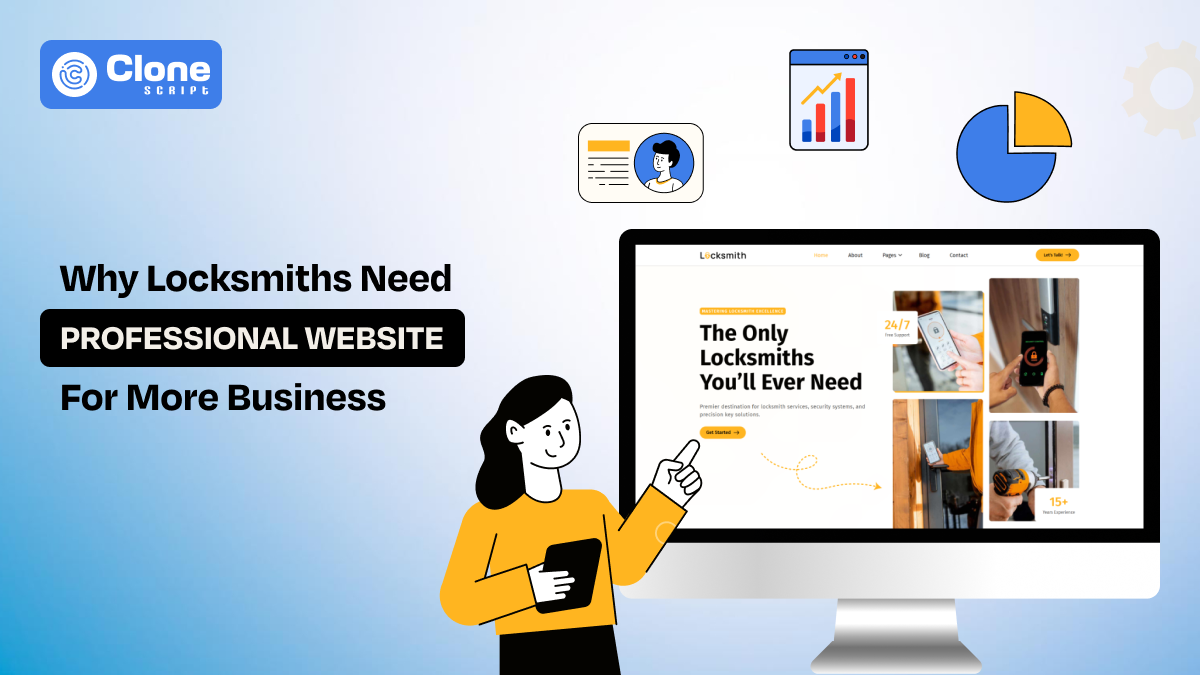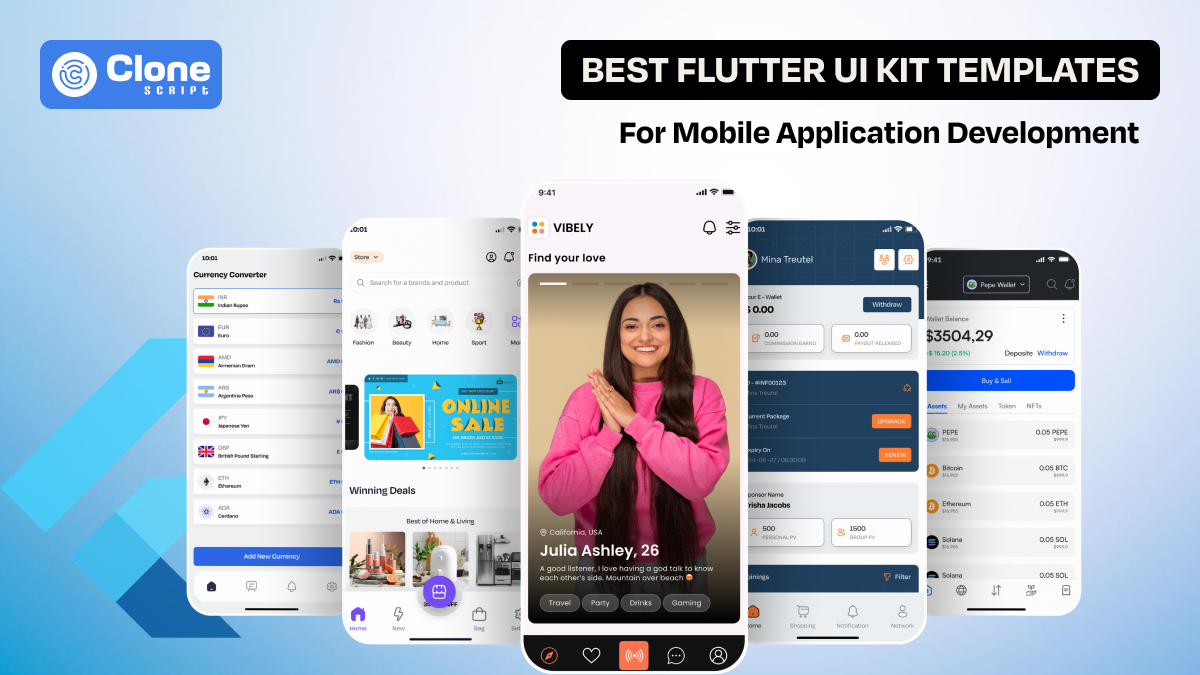10 Common Steps To Develop a Successful Food Delivery Mobile App Like Ubereats and Grubhub
The food delivery industry has witnessed extraordinary growth in recent years. By the end of 2024, the online meal delivery market revenue is forecasted to reach 0.77 US$ trillion which is 22.22% higher than the previous year's actual revenue.
It is driven by the increasing demand for convenience and diverse culinary options. To capitalize on this growing market, entrepreneurs are turning to mobile app development as a strategic tool to establish their brand and reach a wider audience.
According to reports, the USA and China are the two most popular countries relying on online food delivery due to the best infrastructure availability. But now India emerges as another hot-favorite destination to deploy your business of food delivery service.
A well-designed food delivery app can provide a seamless user experience, facilitate efficient order placement, and increase customer loyalty. However, creating a successful app requires a multitude of approaches and diverse thinking that contains various key elements.
In this guide, we will explore the 10 essential steps involved in developing a robust and feature-rich food delivery mobile application. By following these guidelines, you can position your business for long-term success in the competitive landscape of the food delivery industry just like Ubereats and Grubhub does.
Steps to Develop a Modern and User-friendly Food Delivery App
Do you know the reasons for choosing a food delivery application? It can be helpful for making an informed decision.
Knowing the steps for building a food delivery app for food restaurants, creators and their customers, you have to go with a proven approach by following the described steps.
- Deep Market Research
- Conceptualizing
- Focus On App Design and Wireframing
- Choosing the Right Tech Stack
- Start Front-end Development
- Develop Backend
- Add Discussed Features and Functionality
- Test and Bug Fixes
- Deployment
- Maintenance
Let’s understand them.
1. Deep Market Research
Before you jump into the online food delivery industry, you must do market research regarding what are the opportunities and threats that exist there. After that, analyze the available food-ordering apps to know which kind of user interfaces they’re relying on and what’s their USP to get thousands of customers daily.
Now, you have a clear picture of what you have to keep in mind when designing the app for your restaurants clients and customers. Your food delivery app should be solving the customer’s issues and offering them a personalized meal ordering experience at a tap.
For example, with the competitor analysis, you identify some of the readily available food apps are offering limited online payment options and not allowing meal customization choices. This is the best chance to solve these issues by launching a useful mobile app for food ordering and delivery.
2. Conceptualizing
Also, at this step, you have to stick with your business objectives like revenue generation and brand exposure to the market. As the market research is done, it’s time to prepare the complete concept of how your app should be designed for different business models like B2B and B2C.
Define the user flow for both sides: restaurants and customers in a visually appealing manner to eliminate confusion while coding for the application.
-
For resturants
With this approach you can identify which features a food restaurant needs to fulfill the order. Instant reminders for new meal orders and real-time withdrawal processing are helpful for them. Also, the watch timer allowing them to cook fresh and delicious food timely. Once it is ready, the delivery courier partner will pick up it and deliver the food to the customer’s door.
-
For customers
Hungry foodies are eager to order meals online and like to taste the different dishes without visiting the physical cuisines. Your app’s design should stick with their actual needs.
“Keep note: With a pre-defined concept, you can develop an application perfectly that meets customer’s needs for online food ordering, meal customizations, secure payment choices, order history, discount offering, real-time order tracking, and many more.”
For example, when food lovers open the app they’re welcomed with a greeting and attention-grabbing message. After that, the app tour allowing them to search for their favorite food, add to the cart, make payment, and get it on hand in minutes at their doors.
This proactive methodology will make the app usable for millions of customers as Ubereats and GrabHub are successful to retain them.
3. Focusing on App Designing & Wireframing
Focusing on presenting the app concept in a visually effective manner is the third step of food delivery mobile app development.
Here, you have to choose the best UI designing tools like Figma, Uizard, Framer, and Marvel. These tools are delivering extra efforts to bring the best design output for food delivery app. That’s why if you’re focusing on adding something unique to your app make sure you consider it in the designing stage.
When getting the user interface of the food delivery app, it’s time to wireframe it properly and deliver it to the web developers for coding, ensuring the best user experience. App’s UI design wireframing ensures the button placements are accurate, smooth, and intuitive navigation flow, prioritizes the features for needs, and creates a collaborative environment for the entire development life cycle.
You can prefer the food delivery app UI design to save your time and accelerate the development process. The reasons behind choosing the best aesthetic UI designs are as follows: 1. Made with UX design principles, 2. Enhance the user experience, and 3. Cost-effective solution.
4. Choosing the Right Tech Stack
To build a successful food delivery app for each operating device like Android and iOS, make sure you opt for the right development technology. Due to the large amount of tech stack possibilities choosing the best one defines how much time the app development can take for completion.
In addition, to make your food delivery mobile app performance optimal, scalable, and user-friendly it is important to rely on different kinds of technology.
Here are the most used options you should know for development.
A. Mobile Platforms:
-
iOS: For targeting Apple smartphone users, Swift is the primary language.
-
Android: Java or Kotlin are popular choices for food delivery app development for Android devices.
-
Cross-Platform: React Native, Flutter, or Ionic can be used to develop apps for both iOS and Android using a single and reusable codebase.
B. Front-end Development:
-
HTML: Helpful to define the structure of the mobile app.
-
CSS: Prepares attractive layouts and screens for better appearance.
-
Javascript: To add a required and useful functionality based on programming logic.
C. Backend Development:
-
Programming Language: Node.js, Python (with Django or Flask), Ruby on Rails, or Java (with Spring Boot) are the best choices.
-
Database: MongoDB, PostgreSQL, or MySQL are popular options for storing app’s data.
-
Cloud Platform: AWS, Google Cloud Platform, or Microsoft Azure can provide scalable cloud infrastructure and hosting.
D. API Development:
-
REST API: A popular choice for building web APIs that quickly communicate with the front end and back end.
-
GraphQL: An alternative approach that allows clients to request specific data, reducing over-fetching and completing the request handling.
E. Real-time Features:
-
Push Notifications: Use Firebase Cloud Messaging or Apple Push Notification Service for real-time updates regarding discounts or new store openings near customers’ locations.
-
Location Tracking: Integrate with location-based services in food delivery apps like Google Maps or Apple Maps for order tracking.
F. Payment Gateway Integration:
-
Popular Options: To accept and process online payments choose the available payment gateway options like Stripe, PayPal, Braintree, or Razorpay.
-
Security: Assure safe, secure, and relevant payment processing and compliance with relevant regulations.
G. Additional Considerations:
-
Scalability: Choose a tech stack that can handle increasing user loads and data volumes.
-
Performance: Optimize your mobile app for good speed and responsiveness for each device regardless device’s screen size.
-
Security: Implement robust and modern security measures to protect user data, and prevent fraud.
-
Maintainability: Consider the long-term costs and complexity of maintaining the chosen tech stack.
Tech Stack Example for a Food Delivery App:
-
Front-end: React Native (for cross-platform compatibility)
-
Backend: Node.js with Express.js and MongoDB
-
Cloud Platform: AWS or Google Cloud Platform
-
API: REST API
-
Payment Gateway: Stripe or PayPal
5. Start Front-end Development
The fifth step of food delivery mobile app development is start the front-end development often refer as the client-side development.
Consider the answer to the mentioned questions for a better understanding before starting the front-end development.
- Project requirements: What features and functionalities do you need?
- Team expertise: What technologies are your developers familiar with?
- Performance: How important is optimal performance for your app?
- Development time and cost: What is your budget and timeline?
- Future scalability: How will your app need to evolve in the future?
Pick the correct type of front-end mobile app development from the following options:
A. Native App Development
This kind of app development is dedicated to only some specific operating system devices like iOS and Android. If you only targeting Apple users rather than Android ones, you can choose native app development.
Programming languages:
- iOS: Swift (or Objective-C for legacy projects)
- Android: Kotlin (or Java for legacy projects)
Advantages:
- It offers optimal performance and user experience.
- Able to give access to device-specific features and APIs.
Disadvantages:
- Requires separate codebases for iOS and Android.
- It taks a longer time for development.
B. Cross-Platform App Development
Cross-platform app development offers a wide range of advantages, including efficiency, reach, cost-effectiveness, consistency, and rapid updates. Additionally, these apps can provide a consistent user experience across different platforms and allow for easier deployment of updates and bug fixes. It can be a great choice for online food delivery services.
Frameworks:
- React Native: JavaScript framework backed by Facebook, offering a native-like experience.
- Flutter: Google's UI toolkit using Dart programming language, known for its fast performance and rich UI components.
- Ionic: HTML, CSS, and JavaScript framework, building effective hybrid apps with web technologies.
Advantages:
- It requires a single codebase for both iOS and Android.
- Faster development time rather than native app development.
- Easier to maintain and scalable too.
Disadvantages:
- Might have some performance limitations compared to native apps.
- Access to device-specific features might be limited in cross-platform app development.
C. For Progressive Web Apps (PWAs):
These apps are helpful for your food delivery business if you’re looking to capture the market of worldwide consumers who take the help of web for ordering the meal. It means your app is workable properly without being installed in the user’s devices. For new food ordering and delivery services, progressive web apps can be a best option due to it’s enhanced visibility.
Technology and Features
- Technologies: HTML, CSS, and JavaScript are commonly used. Meanwhile, React Native also implemented for a better performance.
- Features: Through PWAs, your food delivery mobile app can have features including but not limited to offline capabilities, push notifications, installability, and web app-like experience.
Advantages:
- PWAs based on single codebase for web and mobile.
- These apps have fast loading times.
- No app store submission process required to use.
Disadvantages:
- Progressive wep apps have limited access to device-specific features.
- Due to single codebase user experience might vary across different browsers and devices.
Ultimately, choosing the best kind of front-end app development depends on your business objectives, budget, and customer’s preferences.
6. App Backend Development
Backend development is the backbone of a successful food delivery app. It is responsible for handling data storage, processing orders, and managing interactions with third-party services.
Here's a breakdown of key areas to focus on:
A. Database Selection:
-
Relational Databases: MySQL, PostgreSQL, or SQL Server required for structured data management of the app.
-
NoSQL Databases: MongoDB, Cassandra, or Firebase databases are best option for flexible and scalable data storage options.
-
Cloud-based Databases: AWS DynamoDB, Google Cloud Firestore, or Azure Cosmos DB for cost-effective cloud databases.
B. Server-Side Programming:
-
Popular Languages: Node.js, Python (Django or Flask), Ruby on Rails, or Java (Spring Boot) are common programming languages to pick for food mobile app.
-
Frameworks: Choose a framework like Laravel that simplifies development and provides essential features.
C. API Development:
-
RESTful APIs: Create well-structured APIs to easily communicate between the front-end and backend systems and fulfill the request.
-
GraphQL: Consider GraphQL for more efficient data fetching and processing about food orders and real-time processing.
D. Authentication and Authorization:
-
User Authentication: Implement secure login mechanisms like as email/password, social media, or 2FA to prevent any kinds of unauthorized access.
-
Authorization: Control access to different app features based on user roles and permissions for enhanced security about restaurants business and customer’s privacy.
E. Order Processing and Management:
-
Workflow: Describe the order lifecycle, from placement to delivery to avoid late order processing and mismanagement.
-
Payment Integration: Integrate with popular payment gateways such as Stripe, PayPal, Braintree to accept online payments and process refunds.
-
Notifications: Send real-time notifications to users about order status, delivery updates, and exclusive promotions.
F. Integration with Third-Party Services:
-
Mapping APIs: Integrate the food delivery app with Google Maps or Apple Maps for location-based services. For example, Ubereats and DoorDash take the help of Google Maps APIs. Grubhub relies on the Apple Maps APIs for navigation.
-
Payment Gateways: Connect applications to payment processors for secure transaction processing. Ubereats uses a Stripe payment gateway, while DoorDash partners with Braintree to process the payments. Grubhub accepts the payment through the PayPal payment processor.
-
Messaging Services: Implement push notifications or in-app messaging like chatbot services. Twilio messaging app is used by Ubereats and Grubhub, while DoorDash opted for SendGrid for chatting with customers.
G. Data Storage and Management:
-
Data Security: Having robust security measures ensures your app protects user data.
-
Data Backup: Regularly back up your database to prevent data loss or misconfiguration.
H. Scalability:
-
Cloud-based Infrastructure: Utilize cloud platforms like AWS, GCP, or Azure for app users scalability.
-
Load Balancing: Distribute traffic across multiple servers to handle increased load and provide service without interruption.
I. Performance Optimization:
-
Caching: Implement caching mechanisms to improve response times and provide solutions.
-
Database Optimization: Optimize database queries and indexes to avoid any loss.
-
Code Optimization: Write efficient and optimized code to effectively communicate with servers and technologies.
By carefully considering these aspects, you can build a secure and scalable backend for your food delivery app. If you have limited knowledge about the technology it’s best to hire a backend developers helping you to integrate the app with backend systems. Make sure you opt out for a agile and expert developers have experience in backend development.
7. Add Discussed Features and Functionality
The seventh step of food delivery mobile app development is to adding a required functionality. A successful delivery app should offer a wide range of features to provide a seamless and enjoyable user experience.
Here are some key features to consider:
A. Core Features:
-
Restaurant Search: A multifaceted search function allows food lovers to find restaurants based on location, cuisine, price range, or user ratings.
-
Menu Browsing: Customers should be able to easily view restaurant menus and dishes, including item descriptions, prices, and images.
-
Order Placement: A simple and intuitive checkout process allows users to place orders with ease and complete understanding.
-
Payment Options: Offer different payment methods as per customer’s preferences, including credit/debit cards, digital wallets, and cash on delivery.
-
Real-time Tracking: Provide customers with real-time updates on their order status, including estimated delivery time, delivery route, and driver location.
-
Reviews and Ratings: Allow food lovers to rate and review restaurants and their orders, helping other new customers to make informed decisions.
B. Additional Features:
-
Personalized Recommendations: Your apps should be designed to suggest restaurants or dishes based on user preferences and past orders.
-
Loyalty Programs: Reward repeat customers with loyalty points or discounts to order food from the app.
-
Customizable Filters: Allow app users to filter search results based on dietary restrictions, additional recommendations, allergies, or preferences.
-
Group Ordering: Offer food lovers to create group orders for celebrating the moments and split payments with a tap.
-
In-App Messaging: Provide a platform for users to communicate with restaurants or delivery drivers to give additional information for meal customization (after order) and relevant delivery time (for surprise).
-
Push Notifications: Your delivery app could be designed to send automated notifications for order updates, promotions, or new restaurant openings.
-
Offline Mode: This feature can be proven as your app’s USP that helps food lovers to browse menus and place orders even without an internet connection.
-
Integration with Third-Party Services: Integrate with popular third-party apps to add more functionality to your app for payment processing, delivery route navigation, and messaging.
By incorporating these features, you can build an online food delivery app that offers a superior user experience and attracts a loyal customer base.
8. Test and Bug Fixes
After adding the features to the app and completing the coding task, it’s a moment to test how the food delivery will work for both restaurants and users who order the food. This step is very important for identifying any vulnerabilities or risks involved.
If the app is being live without QA & testing affecting the user experience and is harmful to the business reputation. Because there may be bugs and viruses affecting the user’s devices and stealing the information.
So, what do you focus on testing the app is mentioned follow.
A. Functional Testing:
-
User Interface (UI) Testing
-
User Experience (UX) Testing
-
Functionality Testing
B. Performance Testing:
-
Load Testing
-
Stress Testing
-
Performance Optimization
C. Compatibility Testing:
-
Device Testing
-
Browser Testing
-
Network Testing
D. Security Testing:
-
Vulnerability Assessment
-
Penetration Testing
-
Data Privacy Compliance
E. Usability Testing:
-
User Interviews
-
Usability Testing
F. Integration Testing:
-
Third-Party Integrations
-
API Testing
G. Regression Testing:
-
Retest Features
By getting a satisfactory report from the app testing, you can ensure your food delivery app is free from any glitches, viruses, bugs, and other issues. It means the app is ready to roll on the market and capture the market share. The app is useful for both restaurants to get food orders online and on the customer side they can make the order at a tap from a smartphone.
9. Deployment & Launch
The ninth step of food delivery app development is to launch it on the Google Play Store and App Store where millions of food lovers are eager to use your app. But for that, you have to own the developer account to deploy your app to those marketplaces. It can be done with some simple steps and providing the essential information, once the app is live they will remind you.
Getting live your app on App stores is not only achievement but a proven successful effort of developers skills and expertise. You can market your app through digital marketing like writing a blog articles, social media ads and search engine ads (Preferably Google Ads) for new user acquisition.
10. Maintenance & Updates
Once the app is deployed on the Play Store and App Store, adding new functionality will increase its organic downloads and ultimately drive success. You keep having to update yourself with customers’ behaviors and configure their demands about the app’s improvement.
Don’t assume having multiple features can be costly for app development but in return, you can get more it. The best customer satisfaction rate is a core indicator of your app’s quick usage for multiple moments.
Ultimately, developing the food ordering and delivery app deepens on these 10 common steps and most of the developers are relying on them. At each development steps, you have to focus on quality, user experience, modern security measurements, and modern but unique features that attracts food restaurants and food lovers.
Choosing an All Clone Script As a Food Delivery App Development Partner
All Clone Script is the correct development partner for on demand food delivery app development. We rely on core five methodologies that are helpful to your business:
-
Research: At this stage, we focus on competitor analysis, conducting stakeholder interviews, and prioritizing user feedback & validation.
-
Strategy: Here our experts are starting the world on product planning, feature list development, and defining the user flow with quality control.
-
Product Design: We rely on consistent brand design throughout the development life cycle. Implementing the UI/UX design principles brings out the best final product.
-
Engineering: Our backend software engineers have diversified skills in APIs and recent tech stacks. We include mobile & web app development with QA & Testing services at this phase.
-
Launch and Growth: Once the app is developed we prepare the plan for App Store optimization and setup to get approval. Also, we monitor the ongoing measurement functionality required for your app. Ultimately, we focus on agile planning & effective release management.
Make your food delivery mobile app safe, easy to use, scalable, modern, and user-friendly with All Clone Script, an app development company.
Simply contact us about your requirements and if possible let us know how much you’re willing to pay. From there we can bring an accurate solution for you and your business without involving any waiting queue.
Don’t miss the chance to capture the share market of online food delivery services by just contacting us.
 BTC - Bitcoin
BTC - Bitcoin
 USDTERC20 - USDT ERC20
USDTERC20 - USDT ERC20
 ETH - Ethereum
ETH - Ethereum
 BNB - Binance
BNB - Binance
 BCH - Bitcoin Cash
BCH - Bitcoin Cash
 DOGE - Dogecoin
DOGE - Dogecoin
 TRX - TRON
TRX - TRON
 USDTTRC20 - USD TRC20
USDTTRC20 - USD TRC20
 LTC - LiteCoin
LTC - LiteCoin







